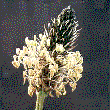
 |
The name has been changed . . .
. . . to confuse us, many gardeners think. Suddenly, a plant you've known all your life as xxxx has changed into yyyy. Who did that? Why? We were all quite happy with the existing name, and now we don't know what we're talking about. There is a reason for changing the name. Perhaps if we understand WHY they've done it, we'll be happier to accept the change, and make an effort to learn the new name.
The Genus Name
There's an international Committee of scientists whose job is to make sure plants have the correct scientific name. Under their rules, the right name is the name given to the plant when it was first discovered and described. Sometimes, we know a plant by a different name. Perhaps the person who first found it was a 'nobody' in scientific terms. Perhaps his (or her) description and name was published in an obscure local paper. So perhaps the first name and description weren't noticed, and later the plant was rediscovered by someone more important, or described in a more widely-read magazine, and the name they gave the plant then became the one everyone used. Then, later, someone discovered the information about the original find, and, under the Committee's rules, the name given to the plant by the second person was invalid, and the plant had to be given the name the first person to find it had given it.
Many people think if we've been using one name for 20 or 30 or 50 years, that should make the name valid, but if you were a descendent of someone who'd found and named a new plant, you might want your ancestor's discovery to be recognised. And it's part of the job of scientists to be accurate. So that's one of the main reasons the name of the Genus might be changed.
The Family Name
A few years ago, 'the experts' decided that all Plant Families should be named after a type plant from that family, and that the names of all the Families should end in 'aceae'. So the names that didn't end in 'aceae' were dropped, even though they were useful in describing attributes of that family: plants in the family Cruciferae had cruciform (cross-shaped) flowers, and plants with composite flowers were in a family called Compositae, and plants that had a legume (bean-type pod) were in a family called Leguminosae. Whilst this change might be nice and neat, it also means that you already have to know the attributes of the type plant to be able to link an unknown plant to that Family. If you aren't already familiar with Brassica, you don't have any idea what other members of the Family Brassicaceae look like, whereas when it was called Cruciferae, four petals in a cross shape gave you a clue.



Recently, there's been a huge upheaval in the way plants are classified, due to the ability of scientists to examine the dna of plants. This has meant that the relationship of plants to one another can be examined, and there is a new system of classifying them, called APGIII, based on their dna. From the gardeners' point of view, the main effect of this reclassification has been that some members of what used to be the Scrophulariaceae Family have been moved into the family Plantaginaceae. I could never identify exactly what characteristics some of the members of the old Family Scrophulariaceae had in common, but putting Antirrhinum, Digitalis and Veronica into a family whose type plant is Plantain is completely beyond the understanding of most gardeners, and guaranteed to confuse rather than enlighten us. The fact that there is still a Family called Scrophulariaceae and plants like Nemesia and Phygelius are still in it doesn't help at all!
The APGIII system has also simplified the Family Malvaceae, so that some plants that used to be classified in separate small families like Sterculiaceae and Tiliaceae are now put together in Malvaceae. On the other hand, several bulbous plants have been shuffled into or out of various small families like Hostaceae and Convallariaceae and put together with others their dna now shows they are closely related to.
All this has complicated plant names so much that gardeners and others growing plants often ignore the taxonomy and still refer to members of the Daisy Family as composite flowers, members of the Brassicaceae as crucifers, and talk about leguminous plants instead of any of the new Families Caesalpiniaceae, Mimosaceae or Papilionaceae. Most seed companies continue to use the old Family names in their catalogues. All this points to an increasing gap between the taxonomic experts concerned with naming plants correctly and people growing the actual plants which is leading to a mutual lack of appreciation for one another's skills.
Because it is important for us all to know which plants we are talking about, I've amended the names of the plants and their Families in the Database to reflect the APGIII system. If they're still better known to gardeners under a previous name, I've also listed them under that name so you can find the plant whatever you prefer to call it. To let you know it's been given a new name, I've highlighted the old name in orange and the new name in green.
There's a table of the plants in the Database whose Genus or Family name has changed recently on this page.
Other entries with information on this topic
Classification of Plants - a table showing the traditional method of classifying plants
Classification of Plants - a table showing the classification of plants under the APGIII system
Common Names Index - the common names of plants mentioned in these pages, with their Latin name
Latin Names - the meanings of some common Latin botanical names
Plant Families - an introduction to Plant Families
Common Names and the Latin names of some popular garden plants
| Back to the Database |
|---|